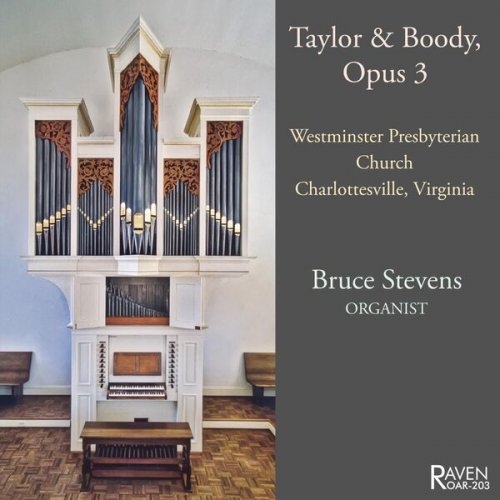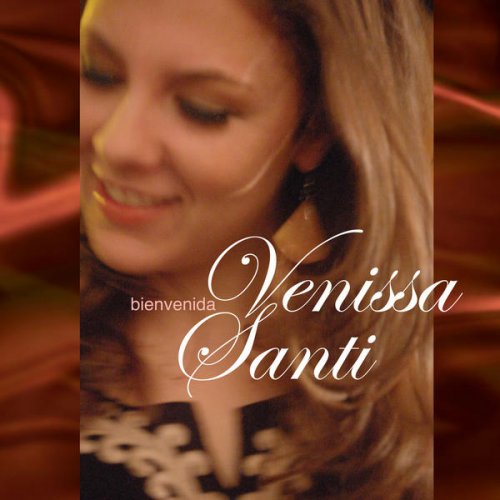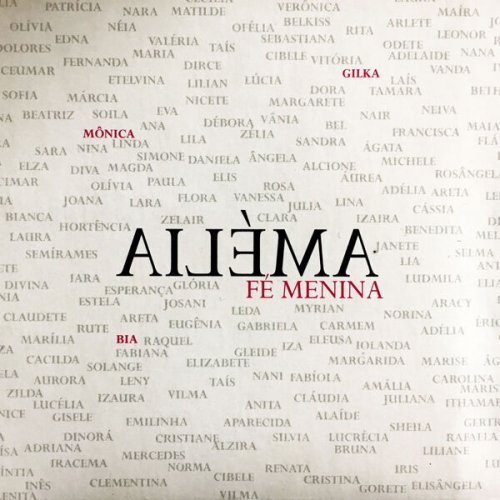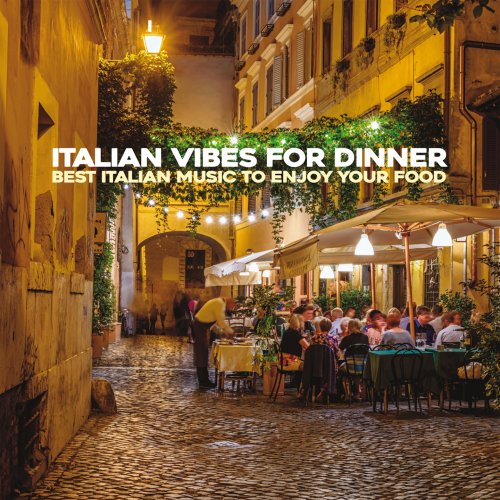Bruce Stevens - Taylor & Boody Op. 3, Westminster Presbyterian Church, Charlottesville, Virginia (2025)

Artist: Bruce Stevens
Title: Taylor & Boody Op. 3, Westminster Presbyterian Church, Charlottesville, Virginia
Year Of Release: 2025
Label: Raven
Genre: Classical
Quality: FLAC (tracks)
Total Time: 1:13:34
Total Size: 314 MB
WebSite: Album Preview
Tracklist:Title: Taylor & Boody Op. 3, Westminster Presbyterian Church, Charlottesville, Virginia
Year Of Release: 2025
Label: Raven
Genre: Classical
Quality: FLAC (tracks)
Total Time: 1:13:34
Total Size: 314 MB
WebSite: Album Preview
1. Bruce Stevens – Prelude and Fugue in D Minor (05:14)
2. Bruce Stevens – Chorale Prelude "Nun bitten wir wen heiligen Geist," BuxWV 209 (03:22)
3. Bruce Stevens – Trio "Allein Gott in der Höh sei Ehr’," BWV 664 (04:56)
4. Bruce Stevens – Passacaglia in D Minor (07:33)
5. Bruce Stevens – Prelude and Fugue in C Major, BWV 566 (10:36)
6. Bruce Stevens – Chorale Partita "Was Gott tut, das ist wohlgetan" (09:55)
7. Bruce Stevens – Variations "Unter der Linden grüne" (Live) (05:41)
8. Bruce Stevens – Chorale Prelude "Schmücke dich, o liebe Seele," BWV 654 (Live) (07:08)
9. Bruce Stevens – Deux danses à Agni Yavishta (Live) (03:57)
10. Bruce Stevens – Sonata I in F Minor, op. 65: I. Allegro (Live) (05:28)
11. Bruce Stevens – Sonata I in F Minor, op. 65: II. Adagio (Live) (03:02)
12. Bruce Stevens – Sonata I in F Minor, op. 65: III. Andante recitativo (Live) (02:52)
13. Bruce Stevens – Sonata I in F Minor, op. 65: IV. Allegro assai vivace (Live) (03:45)
The organ at Westminster Presbyterian Church in Charlottesville, Virginia, was designed and constructed in 1980 by Taylor & Boody Organbuilders in Staunton, Virginia. It is a two-manual tracker (mechanical action) instrument with 18 registers and is designated Opus 3 on our work list. Although it is modeled after classical North German and Dutch instruments of the 17th and 18th centuries, it is not a copy of any particular historic instrument. Rather, in designing it we sought to incorporate many of the characteristics of the historic instruments that we feel are as relevant to church organs today as they were 300 years ago.
The Westminster organ is encased in a free-standing, resonant cabinet of solid poplar and oak painted to complement the interior of the church. The architectural design of the organ case is integrated with the space requirements of the pipework and the mechanical key and stop actions. The case stands upright very much like a person with arms upraised. The windchests for the Hauptwerk and Pedal divisions are housed in the upper case, while the Brustwerk division sits below behind paneled doors. The casework is embellished with moldings and hand-carved mahogany pipe shades. The arrangement of the front pipes, the Principal 8', dictates both the layout of the pipes inside the case and the size of the windchests. The playing action is simple and durable: the robust parts of wood and metal provide a light and responsive control of the pipes' speech. The organ is winded by a small electric blower that fills a cuneiform bellows. Wind is carried to the windchests through narrow wooden canals, which give the music a singing, buoyant quality.
The tonal character and volume of the organ's pipes are adjusted after the organ is installed in the church. Each pipe must be made to blend with its neighbors in its own stop or register. In turn, each stop needs to work well not only as a solo sound, but also in combination with other stops to form cohesive combinations. This fitting of an organ to the acoustics of the room makes it unique among musical instruments, for the sound of the pipes is inseparable from their acoustical environment. Westminster Church is neither large nor overly reverberant, but it provides a clear and flattering acoustical setting for this organ, which has more then 1,000 pipes hand-made out of wood or an alloy of lead and tin.
The instrument is moderate in size. It does not offer the great variety of registers that would be found in a large church or concert organ. Rather, the design is focused on the essentials of a well-developed principal chorus for accompanying the liturgy and leading the singing of hymns. Fortunately, this modest two-manual instrument provides a most suitable medium for the performance of organ literature of the 17th and 18th centuries. One concession to contemporary usage is the inclusion of swell shutters on the back of the Brustwerk enclosure, which can be utilized when the doors on the front are closed.
We feel that the economy of design and durable simplicity of the playing mechanism has much to offer in an age of excess and conspicuous waste. We have confidence that instruments such as the Westminster organ can stand for many generations as testimony to the positive creative ability and artistic achievement of which people of our time are capable.
– Taylor & Boody Organbuilders, John H. Boody, 7 May 1981
The Westminster organ is encased in a free-standing, resonant cabinet of solid poplar and oak painted to complement the interior of the church. The architectural design of the organ case is integrated with the space requirements of the pipework and the mechanical key and stop actions. The case stands upright very much like a person with arms upraised. The windchests for the Hauptwerk and Pedal divisions are housed in the upper case, while the Brustwerk division sits below behind paneled doors. The casework is embellished with moldings and hand-carved mahogany pipe shades. The arrangement of the front pipes, the Principal 8', dictates both the layout of the pipes inside the case and the size of the windchests. The playing action is simple and durable: the robust parts of wood and metal provide a light and responsive control of the pipes' speech. The organ is winded by a small electric blower that fills a cuneiform bellows. Wind is carried to the windchests through narrow wooden canals, which give the music a singing, buoyant quality.
The tonal character and volume of the organ's pipes are adjusted after the organ is installed in the church. Each pipe must be made to blend with its neighbors in its own stop or register. In turn, each stop needs to work well not only as a solo sound, but also in combination with other stops to form cohesive combinations. This fitting of an organ to the acoustics of the room makes it unique among musical instruments, for the sound of the pipes is inseparable from their acoustical environment. Westminster Church is neither large nor overly reverberant, but it provides a clear and flattering acoustical setting for this organ, which has more then 1,000 pipes hand-made out of wood or an alloy of lead and tin.
The instrument is moderate in size. It does not offer the great variety of registers that would be found in a large church or concert organ. Rather, the design is focused on the essentials of a well-developed principal chorus for accompanying the liturgy and leading the singing of hymns. Fortunately, this modest two-manual instrument provides a most suitable medium for the performance of organ literature of the 17th and 18th centuries. One concession to contemporary usage is the inclusion of swell shutters on the back of the Brustwerk enclosure, which can be utilized when the doors on the front are closed.
We feel that the economy of design and durable simplicity of the playing mechanism has much to offer in an age of excess and conspicuous waste. We have confidence that instruments such as the Westminster organ can stand for many generations as testimony to the positive creative ability and artistic achievement of which people of our time are capable.
– Taylor & Boody Organbuilders, John H. Boody, 7 May 1981




![Frank Sinatra - Christmas (Remastered) (2013) [Hi-Res] Frank Sinatra - Christmas (Remastered) (2013) [Hi-Res]](https://www.dibpic.com/uploads/posts/2025-12/1765618088_fsc500.jpg)

![Club Bolero, Armik - A Day in Brazil (2007) [Hi-Res] Club Bolero, Armik - A Day in Brazil (2007) [Hi-Res]](https://img.israbox.com/img/2025-12/15/5l607nskcv4xb0n237d8ngs7q.jpg)
![Tomasz Stańko - Unit (Polish Radio Sessions vol. 2/6) (2025) [Hi-Res] Tomasz Stańko - Unit (Polish Radio Sessions vol. 2/6) (2025) [Hi-Res]](https://www.dibpic.com/uploads/posts/2025-12/1765790300_cover.jpg)
